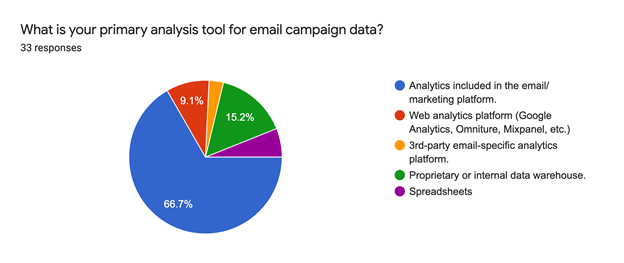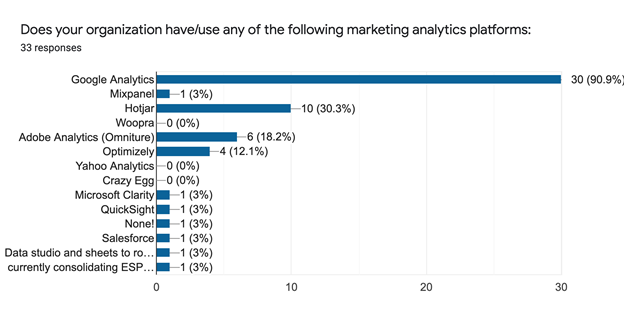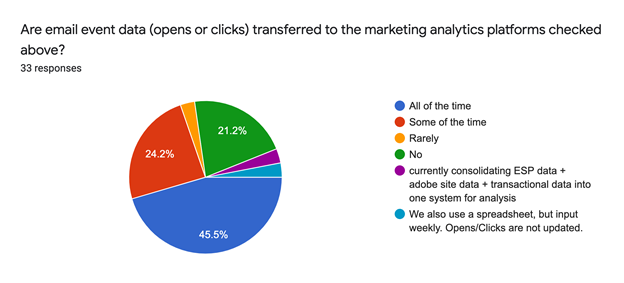How Should Email Marketers Handle Click Metrics?
In this uneasy post-MPP-launch period (early 2022), one consistent theme to email marketing articles/tweets/punditing is “we should be focused on clicks anyway.” Makes sense; clicks are a big signal. Your relationship with the recipient, and your campaign content, have inspired them to act, exiting the email client for the actionable, scriptable, even-more-measurable Land of Web/App.
If a website click is a valuable step for your business, it’s worth following this simplified technical thread of events.
- You send User X an email (with permission, of course).
- They open and read it, and are compelled to click or tap some element in the message.
- The click launches a browser, switches the active application from email to browser
- The browser fetches and renders the web page at that address.
So far so good; they “consumed” the email, now they’re “consuming” the web page.
If your primary business goal is a transaction of some sort, a successful website visit is likely to involve additional actions.
- They might manipulate things on the page where they landed — size, color, quantity, whatever.
- They might sign in to an existing account or create a new one.
- They might visit other pages, return to that page, add things to a “shopping cart” — read more content, watch videos, etc. etc. etc.
- Hopefully they end up transacting — buying, signing up, joining, booking or something.
The digital cash register rings, and that email campaign just paid itself back a little (given typical ratios of send to open, open to click, and click to buy, a few transactions mean success for many, many messages sent). If the web-and-ecomm team is tracking metrics, most of those actions are tracked/tallied/correlated in Google Analytics, Omniture, or something similar.
But that complicated series of web actions started with an email open, then an email click, right? That click handoff from email client to web browser is a critical juncture.
Where & how do you measure clicks?
If you’re an email marketer, apparently, the main platform to understand metrics (including clicks) is the one in your ESP.
We conducted a short 3-question survey of email marketers (via the Only Influencers discussion list, LinkedIn posts, and a couple of swallows towing banners). One swallow doesn’t make a summer, and 33 responses doesn’t an industry benchmark make, but here’s the chart of answers to the question “What is your primary analysis tool for email campaign data?”

Two out of three go for the email platform tools (ESP, etc.)… 16% flexed about their data warehouse. Web analytics platforms were in a 9% dead heat for 3rd/4th place with spreadsheets.
Interestingly enough, the answers to Question 2 (below) suggest that nearly every company also has a (separate) web/marketing analytics platform in place. A whopping 90% checked “Yes” for Google Analytics; a couple of folks with budget muscle are rocking Adobe/Omniture, and you can see the rest on the chart.
Note: The prevalence of Google Analytics in the survey was not really surprising. While GA can be daunting, it’s a superb resource designed to do exactly what the pundits are saying — focus on clicks. It’s built on a petabyte-scale data warehouse (BigQuery), and it comes with 50+ prebuilt reports, plus a custom report-writing system (Datastudio) — and it’s free.

However, hang on: what’s with Question 3 (below)? Most respondents also said that email data (opens or clicks) are not always transferred to said marketing analytics platforms. Email marketers, it seems, prefer to analyze their clickstreams in email tools.

After about 500 words of lead-in, here’s the main argument of this post:
If clicks are moving to the fore as an email metric, and your email data are not flowing into the system where other website actions are measured…are your click metrics returning full value?
Picture Indy and Sallah grinning at each other — “They’re digging in the wrong place!”

Click Metrics: “AND,” not “OR”
I’m not questioning the value of tracking opens and clicks in the ESP, but as a sole-and-only silo, the approach leaves a bunch of potential clickstream-data value on the table. Rich data-driven insights are best built from raw data; comparing reports from different systems isn’t the same thing. I’d go so far as to say that if email data isn’t in the marketing analytics “system of record,” email’s seat at the attribution table is weakened.
From a data-flow point of view, leaving email data out of a common click-metrics platform means missed opportunities galore. Unlike most other digital channels, email actions can be tracked coherently end-to-end, via company-assigned customer identity (with permission/consent — we’re assuming “good actor” email practices here). Your emails to me can include the internal (not PII) ID assigned to me for links, images, and pixels. That means that all of my subsequent clicks can, in theory, be correlated down to the mythical 1:1, all the way back to the email campaign - if all data is in a common platform.
Achieving 1:1 data nirvana isn’t the only missed opportunity, though. In a recent post for the OI Metrics Blog, Jeanne Jennings drove home the point that email diagnostic metrics like CTR aren’t always the best measures of business value; in her case study, the message with lower CTR drove significantly higher revenue.
In other words…measuring the business value of email campaigns requires correlation and analysis of additional non-email business data. The kind of data found in, for example….a marketing analytics platform that captures data from your website and commerce platform.
If the data of the open or the originating click in an email is part of the common analytics dataset, the dots can be connected all the way back, and email can be an accurate, measurable part of the business picture.
When I floated this notion to an experienced email marketer, her objection was that email would generate so much data that other channels would be swamped.
Perhaps. Or perhaps that’s the kind of undue modesty that leaves people scratching for budget and resources. If you want recognition of contribution, isolating “your” clicks in a separate metrics system (that other marketing functions do not use) seems a poor tactic. Isn’t the argument for attribution inherently stronger if attribution is granular, connected, and visible across the organization?
In a data-driven business, data in the base = seat at the table.
Now, I’d be happy to find out that this theory (and survey) is wrong. Maybe it’s common practice to fork email traffic into a common company marketing analytics platform, and to use that platform (as well as the ESP) in email marketing decisions.
But assuming that this guess is right, and that not everyone is convinced…why isn’t email data going there?
Why The Isolation?
My speculation is that it’s part history, part technology, part vendor-driven, and part organizational dynamics.
Historically, digital “marketing analytics” platforms like Google Analytics grew out of website data. Back when dinosaurs roamed the browser, the business guys started pestering us techies for website logs. Urchin saw an opportunity, created a platform, and got acquired by Google ( hence “utm” = Urchin Tracking Module). The mental category “website tracking” is still attached to GA, I suspect. (“The web team owns GA — we have our own analytics;” that kind of thing).
The technology factors are related; to be candid, the still-most-used version of Google Analytics is web-centric. That seems to have led to a general misunderstanding, though: the notion that the only way to feed data into GA is with Javascript on a website. That’s just incorrect (I’ve read responses from well-known email experts on the Email Geeks channel that say as much. Sorry, guys, but no.). Parameterizing an image or hyperlink URL will do the job. Yes, done well that job can get complicated. There are 5 or so well-known utm parameters — but there are around 116 additional parameters in the GA measurement protocol.
What about vendors? In theory, an email platform vendor could make this easier. Does your ESP have a user interface to configure external analytics? I’ve been hands-on with quite a few, and in my experience, the answer is usually “no.”
Documentation from the few I’ve found that do offer analytics connectors are Google Analytics-specific, and don’t go beyond “add 3-4 UTM parameters here.” That’s not a bad first step, but it’s woefully out of date. UTM parameters are from 2005; the detailed GA Measurement Protocol was launched in 2015, and the new Google Analytics 4 was launched in late 2020. Basic UTM params don’t allow for 1:1 tracking, opens/clicks/events distinctions, cohort analysis, and a host of other useful measures.
It’s a bind, though. If your email platform of choice doesn’t connect external analytics feeds, and the time/effort/clunkiness of manual configuration of URLs is more headache than you have time for — hmmm, maybe we’ll just use the email click reports.
As to organizational dynamics; based on prior experiences with web and ecommerce teams, it doesn’t seem like a stretch to expect those teams to have tight controls on “their” analytics — the same kind of this-is-our-sandbox mindset that email teams might have about “their” ESP metrics. Teams tailor tools to their needs; change becomes more difficult the longer a tool is in use. Coordinating data flow, access and report generation are hard enough inside a single team!
Possessive nouns like “theirs” capture the overarching point, though. It’s not “their” data…it’s “our” (company) data. If click data is going to be more front-and-center for email marketing, inclusion of email data (clicks, and even opens, depending on the strength of a company’s 1st-party data and coherence of customer identity across the org) in the platform that measures other clicks seems inevitable.
Should Email Data Be Correlated with Data from Other Channels?
As to the question of whether company email data should be connected to company website and company transaction data…the key term in all three is “company data,” not “email” vs “website” and “transaction.” The idea that email data and other data shouldn’t be connected “because of privacy” may be emotionally appealing, but doesn’t stand logical or legal scrutiny.
For contrasting examples…consider a customer who buys a widget on a website as a result of an email campaign. To ship them their widget and charge their card requires knowledge of who they are and what they bought; does connecting the data about the campaign that prompted the purchase make that purchase any more or less private?
Flip that sequence the other way around, and reconsider. If a customer leaves a widget in the shopping cart, acting on that requires knowledge of the customer and what they almost bought. If that customer has provided an email address and opted in, is it “fair game” to send them an abandoned cart email?
Net net, it seems to me that each company’s privacy policy, terms of service, and opt-in policies should dictate what’s collected and measured. Channel-by-channel decisions about data isolation may, in fact, not serve the business or the customer as well as a bigger-picture holistic approach.
Here’s my personal/pet example, which somehow manages to come up in every other interview I do with email marketers. I’ve been a customer of a fairly well-known sporting goods retailer for well over a decade. I’ve bought thousands of dollars of gear from them for our outdoor activities of choice. I’ve also stayed on their email list — which means a daily email to (mostly) ignore.
The problem is, their left hand (email) and their right hand (web/ecommerce) still aren’t talking after all these years. The right hand knows my activities of choice, but the left hand keeps sending generic blast emails that are (proportionately) mostly irrelevant. I don’t know or care what ESP they use, but they’ll never get answers that make my inbox experience better from their campaign data alone.
How does that feel?

If they combined that campaign/click data with their web and transaction data, we’d both be better off.
I’m sure they have men working on it.
If you’re really interested in this, and are in a position to act…Campaign Genius is working on a “connector” for brands and platforms to pass email data to Google Analytics in real-time. We’re looking for some preview users to help us shape it. Reach out to me directly to learn more - matthew@campaigngenius.io.

 How to resolve AdBlock issue?
How to resolve AdBlock issue? 
 Matthew Dunn is a serial entrepreneur and founder of Campaign-Genius, the live-content automation platform for email.
Matthew Dunn is a serial entrepreneur and founder of Campaign-Genius, the live-content automation platform for email.